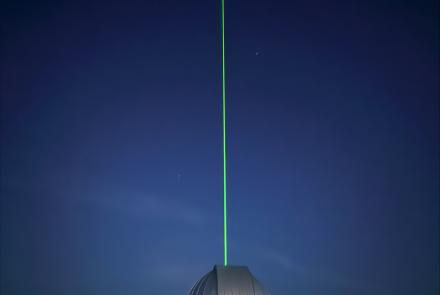

UAF professor’s work is a step toward elusive ‘theory of everything’
Time, not space plus time, might be the single fundamental property in which all physical phenomena occur, according to a new theory by a University of Alaska Fairbanks scientist.
The theory also argues that time comes in three dimensions rather than just the single one we experience as continual forward progression. Space emerges as a secondary manifestation.
“These three time dimensions are the primary fabric of everything, like the canvas of a painting,” said associate research professor Gunther Kletetschka at the UAF Geophysical Institute. “Space still exists with its three dimensions, but it’s more like the paint on the canvas rather than the canvas itself.”
Those thoughts are a marked difference from generally accepted physics, which holds that a single dimension of time plus the three dimensions of space constitute reality. This is known as spacetime, the concept developed more than a century ago that views time and space as one entity.
Kletetschka’s mathematical formula of six total dimensions — of time and space combined — could bring scientists closer to finding the single unifying explanation of the universe.
Dimensions of time beyond our everyday forward progression are difficult to grasp. Theoretical physicists have proposed many variations.
Kletetschka’s work, published April 21 in Reports in Advances of Physical Science, adds to a long-running body of research by theoretical physicists on a subject outside of mainstream physics.
He writes that his mathematical framework for three-dimensional time improves on others’ proposals by making testable reproductions of known particle masses and other physical properties.
“Earlier 3D time proposals were primarily mathematical constructs without these concrete experimental connections,” he said. “My work transforms the concept from an interesting mathematical possibility into a physically testable theory with multiple independent verification channels.”
The theory could be used to predict currently unknown particle properties and aid in pursuing the origin of mass — and, ultimately, helping solve one of the biggest questions in physics.
What is 3D time?
Three-dimensional time is a theory in which time, like space, has multiple independent directions — typically imagined as three axes of time motion, similar in concept to the spatial X, Y and Z axes.
Imagine you are walking down a straight path, moving forward and therefore experiencing time as we know it. Now imagine another path that crosses the first one, going sideways.
If you could step onto that sideways path and remain in the same moment of “regular time,” you might find that things could be slightly different — perhaps a different version of the same day. Moving along this perpendicular second path could let you explore different outcomes of that day without going backward or forward in time as we know it.
The existence of those different outcomes is the second dimension of time. The means to transition from one outcome to another is the third dimension.
Kletetschka said his theory overcomes some of the problems with earlier three-dimensional time theories that are based on traditional physics.
Those earlier theories, for example, describe multiple time dimensions in which cause-and-effect relationships are potentially ambiguous. Kletetschka’s theory ensures that causes still precede effects, even with multiple time dimensions, just in a more complex mathematical structure.
In three-dimensional time, the second and third dimensions are thought by some researchers, notably theoretical physicist Itzhak Bars of the University of Southern California, to become apparent, or unfold, at levels of extreme energy such as during the early universe or in high-energy particle interactions.
A grand unifier?
The pursuit of three-dimensional time theory is believed by Bars and other theoretical physicists to be an avenue for helping answer some big physics questions that have stumped scientists.
Kletetschka’s approach might even help resolve the grandest of all unresolved physics challenges: unifying quantum mechanics — the behavior of particles at the smallest scales — and gravity into a single quantum theory of gravity.
A quantum theory of gravity could lead to, or become, a grand theory of the universe — the so-called “theory of everything.” The elusive unifying theory would unite the four fundamental forces of nature — electromagnetism, strong nuclear force, weak nuclear force and gravity.
The standard model of particle physics unites the first three. Gravity is explained through Albert Einstein’s general theory of relativity.
The two are incompatible, so physicists have been searching for that “theory of everything” to unite them. Finding the origin of particle masses is central in that pursuit.
Kletetschka believes his theory of three-dimensional time can help. His framework accurately reproduces the known masses of particles such as electrons, muons and quarks and also explains why these particles have these masses.
“The path to unification might require fundamentally reconsidering the nature of physical reality itself,” he said. “This theory demonstrates how viewing time as three-dimensional can naturally resolve multiple physics puzzles through a single coherent mathematical framework.”
• Gunther Kletetschka, University of Alaska Fairbanks Geophysical Institute, gkletetschka@alaska.edu
• Rod Boyce, University of Alaska Fairbanks Geophysical Institute, 907-474-7185, rcboyce@alaska.edu






